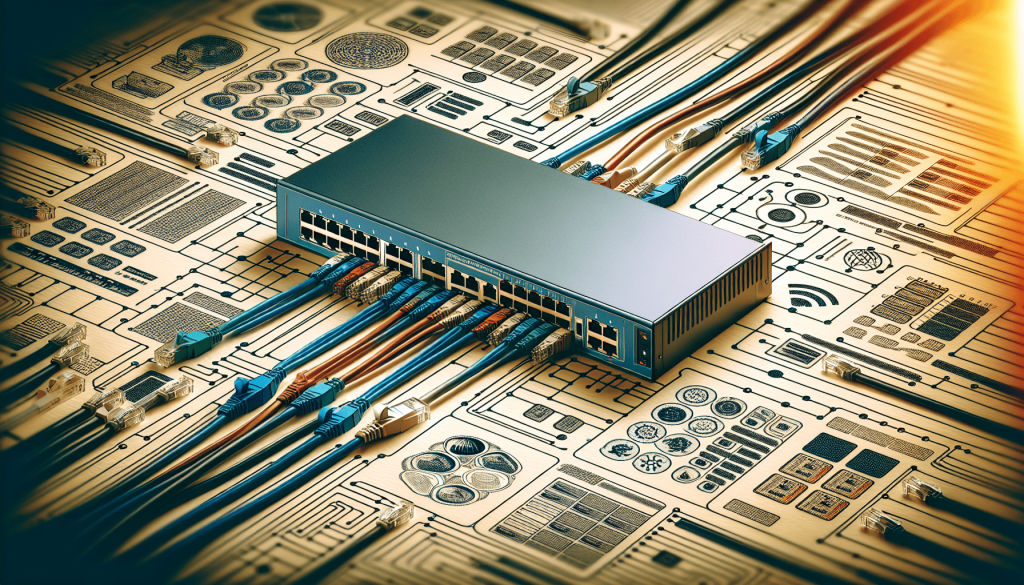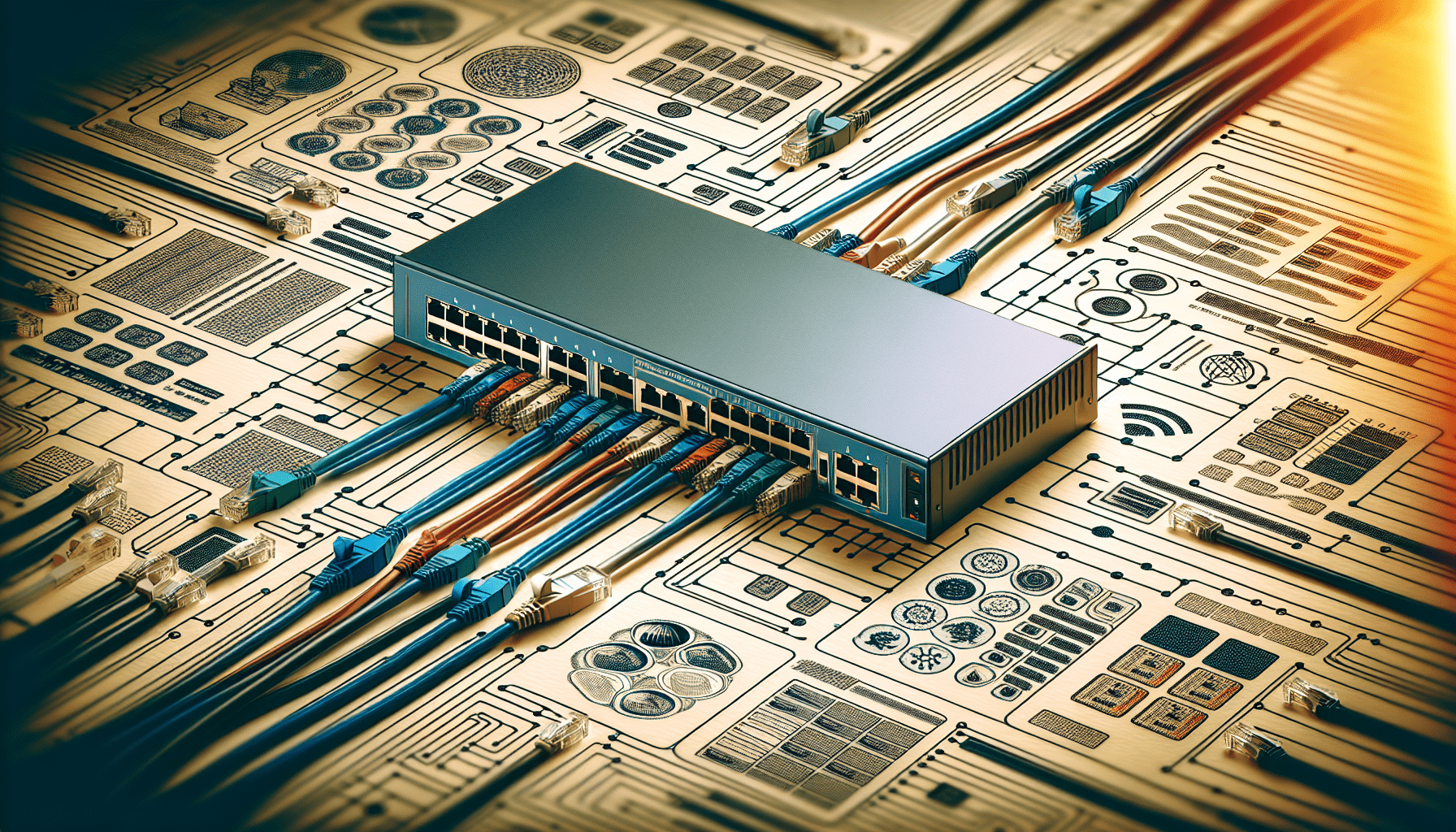So you’ve decided to set up a network switch, but you’re not quite sure where to start. Don’t worry, we’ve got you covered! In this comprehensive guide, we will take you through the entire process of setting up a network switch, step by step. Whether you’re a beginner or have some experience, this article will provide you with all the information you need to successfully configure your network switch and ensure smooth and efficient communication between devices. So grab your notepad and get ready to become a networking pro!
Choosing the Right Network Switch
When it comes to choosing the right network switch, there are a few factors you should consider. First and foremost, think about the number of ports you will need. This will depend on the size of your network and the number of devices you plan to connect. It’s always a good idea to have a few extra ports for future expansion.
Next, determine the required speed and bandwidth for your network. If you have a lot of data-intensive tasks or devices that require high-speed internet access, you’ll want a switch that can handle the demand. Consider the maximum data transfer rate and the bandwidth capacity of each switch you are considering.
Another important consideration is whether you need a managed or unmanaged switch. A managed switch allows for more control and customization of your network settings. You can prioritize certain devices or applications, set up virtual LANs (VLANs), and configure access control lists (ACLs). On the other hand, an unmanaged switch is more plug-and-play, requiring minimal setup and maintenance.
Lastly, take power over Ethernet (PoE) into account. If you have devices such as wireless access points, IP cameras, or VoIP phones that require power and data to be transmitted over a single Ethernet cable, you’ll need a switch that supports PoE. This can help simplify your network setup and eliminate the need for additional power adapters.
Planning the Physical Setup
Before you start setting up your network switch, it’s important to plan the physical layout. Identify the optimal switch location, considering factors such as proximity to your network devices and the availability of power outlets. You’ll also want to ensure that the switch is easily accessible for maintenance and troubleshooting purposes.
Additionally, consider whether rack or wall mounting options are the best fit for your setup. Rack mounting can help save space and keep everything organized if you have multiple switches or other networking equipment. On the other hand, wall mounting may be more suitable if you have limited space or want to keep the switch out of reach.

Preparing the Network Environment
To ensure a stable network environment, make sure you have a reliable power source. Use surge protectors or uninterruptible power supplies (UPS) to protect your switch from power surges and outages. This will help prevent any potential disruptions to your network.
Evaluate environmental factors such as temperature and humidity. Network switches should be kept in a cool, well-ventilated area to prevent overheating. Avoid placing the switch near sources of excessive heat or in areas with high humidity levels. These environmental factors can affect the performance and lifespan of your switch.
Lastly, verify that you have sufficient network cabling to connect all your devices to the switch. Ensure that the cables are in good condition and meet the required standards for your network. Consider using Ethernet cables with higher data transfer rates, such as Cat6 or Cat6a, for better performance.
Configuring the Network Switch
Once you have physically set up your network switch, it’s time to configure it for optimal performance. Start by connecting the switch to power using the provided power adapter or PoE if applicable. Make sure the power source is stable and reliable.
Next, connect your network devices to the switch ports using Ethernet cables. Ensure that the cables are securely plugged in on both ends to establish a solid connection. Consider organizing the cables and using cable ties or cable management solutions to keep everything tidy and prevent tangling.
To access the switch’s configuration interface, you will need to connect a computer to one of the switch ports. Open a web browser and enter the switch’s default IP address or hostname. This information can usually be found in the switch’s user manual. Once you are connected, you will be prompted to log in with the default administrator username and password.
Configure the basic network settings, such as the IP address, subnet mask, and default gateway, for the switch. This will allow it to communicate with other devices on your network. It’s important to choose unique IP addresses within your network range to avoid conflicts.
If your network requires the use of VLANs to segregate traffic or improve security, enable VLANs on the switch. This will allow you to assign different ports or groups of ports to separate VLANs. You can also configure port-based VLANs or assign VLANs based on MAC addresses.
Set up quality of service (QoS) to prioritize certain types of network traffic. This can be useful if you have applications or devices that require a higher level of service, such as VoIP or video streaming. QoS allows you to allocate bandwidth and control the latency, jitter, and packet loss of specific traffic.
Implement access control lists (ACLs) to control network traffic and enhance security. ACLs allow you to define rules that determine which traffic is allowed or denied based on factors such as source IP addresses, destination IP addresses, or specific protocols. This can help protect your network from unauthorized access or potential attacks.
Enable spanning tree protocol (STP) to prevent network loops and ensure network redundancy. STP allows switches to communicate and create a loop-free topology by blocking or disabling redundant paths. This helps maintain a stable and reliable network by preventing packet flooding and network congestion.

Testing and Troubleshooting
After configuring the network switch, it’s crucial to test and troubleshoot to ensure everything is working as expected. Use network testing tools, such as ping or traceroute, to verify connectivity between network devices. This will help you diagnose any potential issues and ensure that all devices are communicating properly.
Check the switch status and diagnose common issues by accessing the switch’s management interface. Look for any error messages or alerts that could indicate a problem. Check the link status and speed for each port to ensure proper connection and performance.
Implement redundancy measures to ensure network availability in case of failures. This can include setting up link aggregation or using multiple switches in a stack. Link aggregation combines multiple Ethernet connections into a single logical link, providing increased capacity and failover protection. Stacking allows switches to operate as a single unit, simplifying management and providing redundancy.
Monitoring and Maintenance
To keep your network switch operating efficiently, set up Simple Network Management Protocol (SNMP) monitoring. SNMP allows you to monitor the performance and health of your switch, including factors such as CPU and memory usage, port status, and network traffic. This can help you detect any potential issues or bottlenecks before they cause major problems.
Regularly update the firmware and security patches for your network switch. Check the manufacturer’s website for updates and follow their instructions for installation. Firmware updates can provide bug fixes, performance improvements, and new features. Security patches help protect your switch from known vulnerabilities or exploits.
Perform regular backups of your switch configuration. This will allow you to quickly restore the configuration in case of a failure or if you need to replace the switch. Store the backups in a secure location, preferably off-site, to ensure data safety.
Expanding and Upgrading the Network Switch
As your network grows, you may need to expand or upgrade your network switch. Consider stacking or link aggregation to increase capacity and create redundancy. Stacking multiple switches allows you to manage them as a single entity and provides scalability. Link aggregation, as mentioned earlier, combines multiple connections for increased bandwidth and failover protection.
Evaluate the need for Power over Ethernet Plus (PoE+) or 10 Gigabit Ethernet (10GbE). If you have devices that require more power than standard PoE provides, such as high-power wireless access points or PTZ cameras, PoE+ may be necessary. Similarly, if you have devices that require higher data transfer rates, such as servers or storage systems, 10GbE can provide the necessary bandwidth.
Always plan for future growth when setting up your network switch. Anticipate the number of devices you may add in the future and ensure that your switch has enough ports and capacity to accommodate them. It’s better to have a little extra capacity now rather than struggle to upgrade or replace your switch later.
Network Switch Security
Security is a crucial aspect of network switch setup. Change the default administrator password immediately after setting up the switch. Use a strong, unique password that is not easily guessable. This will help prevent unauthorized access to the switch’s configuration and management interface.
Implement port security to control access to your network. Set up MAC address filtering to restrict which devices can connect to the switch ports. This ensures that only authorized devices are allowed to connect, enhancing network security.
Enable firewall and intrusion prevention systems (IPS) on your network switch if available. Firewalls help monitor and control network traffic, blocking any suspicious or malicious activity. IPS systems detect and prevent unauthorized access attempts or potential attacks, keeping your network safe and secure.
Network Switch Best Practices
To ensure a well-organized and reliable network, follow these best practices:
-
Label and document network connections: Properly label cables and document which devices are connected to each port. This will make it easier to troubleshoot and manage your network in the future.
-
Follow proper cable management guidelines: Use cable ties, cable management racks, or cable trays to keep your cables neat and tidy. This not only improves the aesthetics of your network but also prevents cable damage and interference.
-
Use static IP addresses for critical network devices: Assigning static IP addresses to devices such as servers, routers, or network printers ensures consistent connectivity and makes it easier to manage and configure these devices.
Conclusion
Setting up a network switch may seem like a daunting task, but with the right planning and implementation, it can be relatively straightforward. By considering factors such as the number of ports needed, required speed and bandwidth, and the need for managed or unmanaged switches, you can make an informed decision. Planning the physical setup, preparing the network environment, and configuring the network switch correctly are essential for optimal performance. Regular monitoring, maintenance, and security measures help ensure the long-term stability and security of your network. Lastly, always review and test the functionality of your network switch and seek professional assistance if needed. With these steps in mind, you’ll be well on your way to setting up an efficient and resilient network switch.
